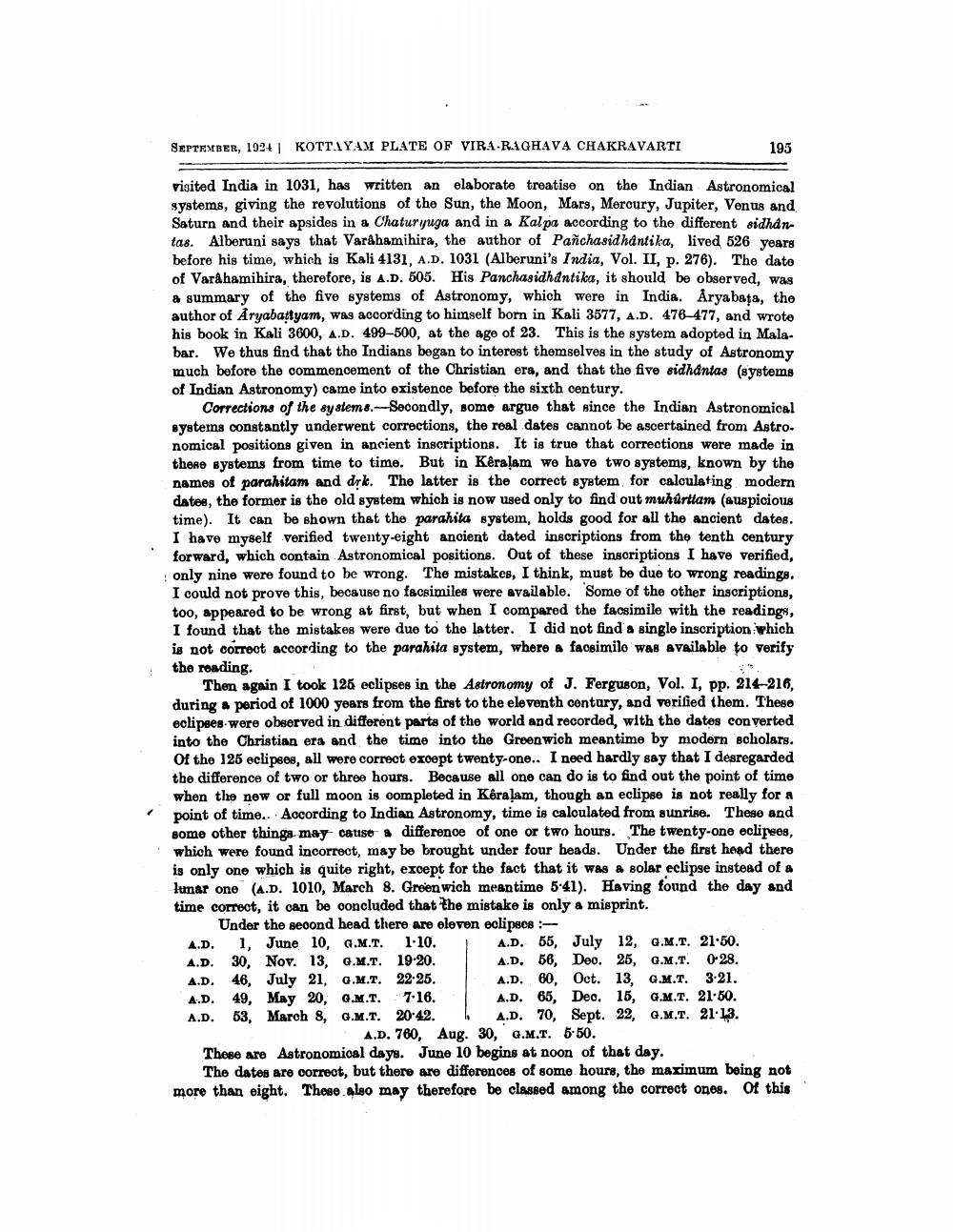________________
SEPTEMBER, 1934 KOTTAYAM PLATE OF VIRA RAGHAVA CHAKRAVARTI
195
visited India in 1031, has written an elaborate treatise on the Indian Astronomical systems, giving the revolutions of the Sun, the Moon, Mars, Mercury, Jupiter, Venus and Saturn and their apsides in a Chaturyuga and in a Kalpa according to the different sidhantas. Alberuni says that Varahamihira, the author of Panchasidhantika, lived 526 years before his time, which is Kali 4131, A.D. 1031 (Alberuni's India, Vol. II, p. 276). The date of Varahamihira, therefore, is A.D. 505. His Panchasidhantika, it should be observed, was & summary of the five systems of Astronomy, which were in India. Arya bata, the author of Aryabattyam, was according to himself born in Kali 3577, A.D. 476 477, and wrote his book in Kali 3600, A.D. 499–500, at the age of 23. This is the system adopted in Malabar. We thus find that the Indians began to interest themselves in the study of Astronomy much before the commencement of the Christian era, and that the five sidhantas (systems of Indian Astronomy) came into existence before the sixth century.
Corrections of the systems.--Secondly, some argue that since the Indian Astronomical systems constantly underwent corrections, the real dates cannot be ascertained from Astro. nomical positions given in ancient inscriptions. It is true that corrections were made in thene systems from time to time. But in Keralam we have two systems, known by the names of parahitam and drk. The latter is the correct system for calculating modern datee, the former is the old system which is now used only to find out muhurtham (auspicious time). It can be shown that the parahita system, holds good for all the ancient dates. I have myself verified twenty-eight ancient dated inscriptions from the tenth century forward, which contain Astronomical positions. Out of these inscriptions I have verified, only nine were found to be wrong. The mistakes, I think, must be due to wrong readings. I could not prove this, because no facsimiles were available. Some of the other inscriptions, too, appeared to be wrong at first, but when I compared the facsimile with the readings, I found that the mistakes were due to the latter. I did not find a single inscription which is not correct according to the parahita system, where a facsimilo was available to verify the reading.
Then again I took 126 eclipses in the Astronomy of J. Ferguson, Vol. I, pp. 214-216, during a period of 1000 years from the first to the eleventh century, and verified them. These eclipses were observed in different parts of the world and recorded, with the dates con verted into the Christian era and the time into the Greenwich meantime by modern scholars. Of the 125 eclipses, all were correct except twenty-one.. I need hardly say that I desregarded the difference of two or three hours. Because all one can do is to find out the point of time when the new or full moon is completed in Keralam, though an eclipse is not really for a point of time. According to Indian Astronomy, time is calculated from sunrise. These and some other things may cause difference of one or two hours. The twenty-one eclirees, which were found incorrect, may be brought under four heads. Under the first head there is only one which is quite right, exoept for the fact that it was a solar eclipse instead of a lunar one (A.D. 1010, March 8. Greenwich meantime 5:41). Having found the day and time correct, it can be concluded that the mistake is only a misprint.
Under the second head there are eleven eclipses : A.D. 1, June 10, G.M.T. 1.10. 1 A.D. 55, July 12, G.M.T. 2150. A.D. 30, Nov. 13, G.M.T. 19-20. A.D. 56, Deo. 25, G.M.T. 0-28. A.D. 46, July 21, G.M.T. 22:25. A.D. 60, Oct. 13, G.M.T. 3.21. A.D. 49, May 20, G.M.T. 7.16. A.D. 65, Dec. 15, G.M.T. 21:50. A.D. 53, March 8, G.M.T. 20-42. A.D. 70, Sept. 22, G.M.T. 2113.
A.D. 760, Aug. 30, G.M.T. 5.50. These are Astronomical days. June 10 begins at noon of that day.
The dates are correct, but there are differences of some hours, the maximum being not more than eight. These also may therefore be classed among the correct ones. Of this




